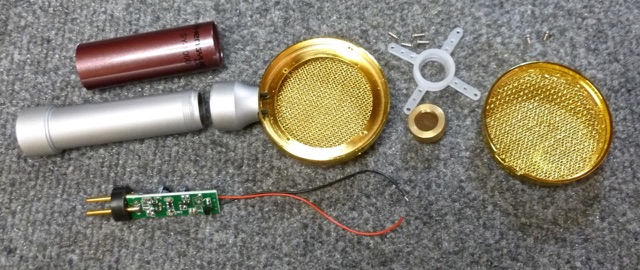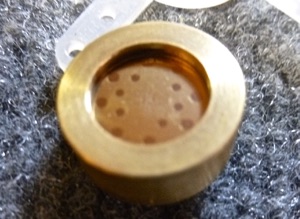E-1000 Microphone

E-1000 Chinese Condenser Mic
Monday, February 2, 2015

I bought a pair of E-1000 condenser mics on eBay, figuring to remove the works and install a large diameter capsule and the new pencil mic electronics kit from Microphone-Parts.com. The new upgrade kit is aimed at all of MXL’s small condenser models such as the 991, 551, 603, and 840. It turns out the M-P kit won’t fit, in fact not much WILL fit except the electronic module that comes in the mic, because the body is built of inner and outer tubes, and the inner tube ID is very small.
I bought a couple of E-1000 Chinese mics to use for chassis.

The electronic module is surface mount, and shares the circuit of the BM-700, K-5000, and other low-cost karaoke mics which I’ve been using for chassis. See analysis here.
So I decided to work with the existing circuit, adding an R-C filter to the voltage regulator output. There isn’t room for through-hole parts, so a trace was cut, solder mask scraped away, and a 470 ohm surface mount resistor installed across the cut. A pair of 47 uF / 16 V solid tantalum caps were installed across the power pads at the input end of the board. Exacting, careful work requiring a magnifier and fine soldering iron. This is not a mod for surface mount newbies.


Added 470R
Added 47uF cap, another on bottom of PCB

Notice that on tantalum caps, the stripe is on the positive terminal.
Having decided to use the existing amplifier electronics, we need to use either an electret capsule or build a very tiny DC - DC converter to polarize a conventional capsule. The capsule which came in the mic is a mid-size brass electret which I haven’t seen before.

It sounds promising, and I’ll investigate it in the future. I also have a sample large diameter electret capsule to work with, so at least initially I don’t have to see how small an oscillator I can build.
All of these electret mics based on this circuit have polarity reversed from standard, that is, the wires from pins 2 & 3 are backwards. This is a side effect of 5V PIP computer sound card compatibility. For studio use on 48V phantom power, that should be fixed. Unfortunately,
there is an error in the PCB layout of these smaller mics at the XLR connector, so moving the output resistors to the alternate pads doesn’t work. You need to cut a trace and run a jumper or two.
There are several capsules on my list to check out, and a couple of capsule mods I’m working on, and one of those will probably wind up in these mics. Stay tuned.
UPDATE 2024: I got to wondering if these older skinny green mic boards have the same problem with emitter and collector swapped as the black and red boards from China. Turns out they do, so that needs to be fixed. Afterwards, the thin bass response problem goes away.
See More China Mics for more info. This PCB is open enough around the offending transistor to unsolder the emitter and collector, swing the transistor so the emitter hits the former collector pad, and run a jumper from the collector to the former emitter pad leaving the base attached to the board. There are a couple of other errors in this PCB layout, and I suspect this copy of the Universal China Mic is where the phase inverter problem was introduced as others copied the circuit for pencil mics.


